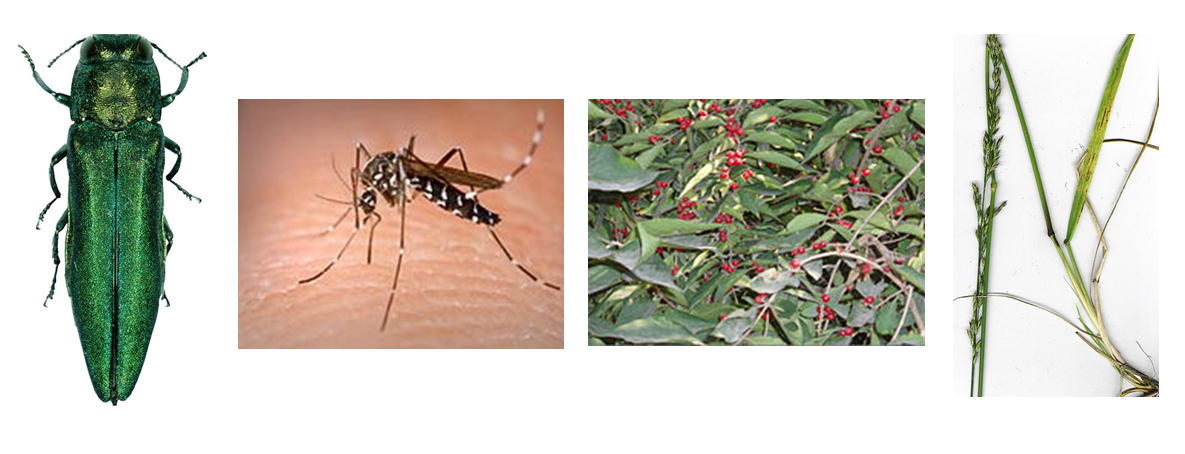
|
|
| Bluegrass Ecology | |
|
Overview and Links to EREC The stream-dissected rolling karst landscape of the Bluegrass formed on a geological feature known as the Jessamine Dome, which raised phosphatic Ordovician limestone containing some clay layers to the surface. The temperate mixed-mesophytic deciduous forest that formed on top following the Pleistocene was considered the most ecologically unusual region of that vast former forest expanse by its most assiduous student, E. Lucy Braun (1950). The pre-European-settlement forest contained bison trails featuring the regular disturbances on which some now-endangered species depend (e.g. Running Buffalo Clover, Trilolium stoloniferum). Karst areas are often prone to drought, even in relatively mesic areas like the Bluegrass (~120 cm of rainfall/year), facilitating the formation by fire of meadows, the characteristic large cane-breaks (Arundinaria gigantea), and the famous mesic savanna-woodlands. These park-like open woodlands with tall grass cover beneath were a major attraction for settlers streaming into Kentucky through the Cumberland Gap in the late 18th and early 19th centuries, facilitating the ultimate settling by Americans of the western US (Leopold 1949, p. 241). There is scientific controversy at present over whether the savannas were natural or anthropogenic (McEwan and McCarthy 2008), with more work required to settle the issue.
|
|

|
Characteristic native species, left to right: Running buffalo clover, native cane, chinkapin oak, and blue ash. |
|
The best remnant of these savanna woodlands is Griffith Woods, about 20 mi north of EREC on the same road. Griffith Woods is under active study by researchers of savanna origins and others engaged in restoration ecology who are pursuing related work at ERF. There are many remaining ancient (> 300 years of age) trees characteristic of the region at Griffith Woods and on farms throughout the area; most notable are the Bur Oak (Quercus macrocarpa), Chinkapin Oak (Quercus muehlenbergii), and Blue Ash (Fraxinus quadrangulata). The invasive Emerald Ash Borer (Agrilus planipennis), newly arrived in the Bluegrass, is a serious threat to these remaining majestic ash trees. Another new and rapidly spreading arrival is the disease-carrying Asian Tiger Mosquito (Aedes albopictus), for which a biological control experiment is planned at ERF. The region also has serious issues with invasive plants, particularly Amur Honeysuckle (Lonicera maackii), Wintercreeper (Euonymus fortunii), and Tall Fescue grass (Festuca arundinacea), all present in abundance at ERF and under study there. Wildlife diseases (e.g. cervid tuberculosis) and disease risks (e.g. chronic wasting disease) are increasing in the region, including those capable of infecting humans (West Nile virus, Lyme disease, Hanta virus). These invaders and diseases are an emerging focus of study at EREC.
|
|

|
Problematic invasive species, left to right: emerald ash borer, Asian tiger mosquito, Amur honeysuckle, tall fescue. |
|
The unique and cultural features of the Bluegrass are well appreciated world-wide, resulting in its recent designation of the region as a World Heritage Site. This emphasizes the urgency of understanding and addressing problematic human-facilitated changes such as the arrival of many diseases and invasive species. Yet EREC is the only field station combining research and education in the Bluegrass (Richter et al. 2010), underscoring its importance and potential. Some Study Sites in the Central Bluegrass Related to Ongoing Research Many Bluegrass farms allow research access to streams, trees, and other relevant organisms and habitats. Accessible sites with characteristic Bluegrass organisms, populations, communities, ecosystems, and landscapes—with varying potential for conducting research on site—include the following:
|
|
|
References
|
|